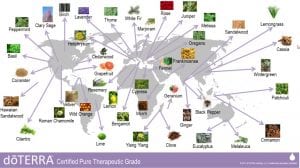FOUR
The Extraction Methods doTERRA Uses.
Essential oil quality is notably one of the most debated subjects among essential oil enthusiasts. There are differing opinions on what an essential oil is and how it should be extracted and even used. Many have learned that a statement of purity on the label does not necessarily mean a guarantee of quality and are left disappointed. dōTERRA recognizes that when you turn to essential oils as part of your health-care regimen, you expect positive results. Our CPTG Certified Pure Therapeutic Grade® trademark represents the dōTERRA quality assurance standard of nature’s most pure and potent plant extracts carefully selected from growers around the globe and quality checked by the world’s brightest, most competent chemists.
A quick review of chemistry establishes that an essential oil is comprised of volatile aromatic compounds; a lesser known principle, however, is how essential oil chemistry reaches its maximum potency in each individual plant. Providing each plant its own individual aromatic profile and other characteristics, aromatic compounds may be partially or, at times, dramatically altered due to environmental factors. Although each individual environmental factor cannot be directly controlled—such as rainfall, seasonal temperatures, etc—sourcing appropriate plant material is fundamental to ensuring therapeutic benefit. Developing long-lasting and often exclusive relationships with growers throughout the world ensures sourcing longevity and the opportunity to select plants from the most appropriate environments for each plant or oil profile.
EXTRACTION METHODS
Varying extraction methods are used in order to remove the aromatic compounds from plant material. Oftentimes, toxic solvents are used to separate the essential oil from its corresponding plant—a practice dōTERRA is adamantly opposed to. dōTERRA primarily uses two types of essential oil extraction: steam distillation and expression. Both of these processes are organic.
STEAM DISTILLATION
Steam distillation is the most common way to extract aromatic compounds (essential oil) from a plant. During the steam distillation process, steam passes through the plant material. The combination of heated steam and gentle pressure causes the essential oil to be released from microscopic protective sacs. As the vapor mixture flows through a condenser and cools, it yields a layer of oil and a layer of water. The essential oil rises to the top and is separated from the hydrosol (floral water) and collected.
Some have asked about the difference between first distillations in comparison to complete distillations. Truth be known, almost all essential oils are distilled in a single process, so a first distillation anda complete distillation are one in the same. One exception is ylang ylang because it is highly prized in the perfume industry where varying aromatic compounds are desired dependent upon their molecular weight and aroma. A disrupted distillation process is oftentimes used where “extra”, I, II, III, and “complete” essential oil classes are collected. dōTERRA uses ylang ylang complete wherein the blossoms are steam distilled in a single process so that all of the aromatic compounds from the plant material is collected. We use ylang ylang complete because we source essential oil for therapeutic benefit rather than for perfumery purposes. The temperature for steam distilling is usually between 140–212 degrees Fahrenheit. Since different plants require different pressures, times, and temperatures, using this particular distillation method makes it possible to adjust the temperature based on the plant type, making it a very effective and precise way to obtain the purest compounds.
For example, dōTERRA Hawaiian Sandalwood essential oil undergoes a laborious and time-consuming procedure. To collect the oil from the actual wood, the outer layers of the wood are stripped from the heartwood. The heartwood is then chipped, filtered, and then chipped again into finer pieces before undergoing a 36-hour steam distillation process of high pressure and high heat. The whole process requires enormous amounts of fuel, energy, and time, making this exquisite essential oil so valuable. In comparison, the steam distillation process of Peppermint typically takes less than two hours with very low heat and pressure.
EXPRESSION
Unlike steam distillation, expression, sometimes referred to as “cold pressed,” does not involve heat. In this process, oil is extracted from the product under mechanical pressure. dōTERRA uses expression to extract all of its citrus oils, such as Wild Orange, Lemon, Lime, Bergamot, and Grapefruit, from the rind.
Regardless of the care, and skill exercised in plant selection, care and harvest, much of the quality can either be preserved or diminished during the distillation process. Proper distillation requires a consideration for the uniqueness of pressure, temperature, time, and harvesting practices, each of which may be as diverse as the plants themselves. A poor distillation process can alter or destroy the necessary aromatic compounds that comprise the essential oil, leaving a substance far different from the intended goal and something that would not be used to support health and wellness. For this reason, the best distillation artisans dedicate their efforts and work to only a few select plants. This focused effort develops proper knowledge and experience, helping ensure congruency between the oil chemistry of the plant and its distilled form.
dōTERRA works with a network of distilleries throughout the world, relying on expertise that has been proven over time. Distillation is both an art and a science.
The art and science of proper distillation can create a pure and potent essential oil with beautiful properties that promote well-being for you and your family. This is just one of many aspects of the dōTERRA CPTG Certified Pure Therapeutic Grade quality assurance standard that allow us to offer products you can trust.
– See more at: http://doterrablog.com/distilling-essential-oils-a-work-of-art-and-science/#sthash.T6cNu6Lh.dpuf



